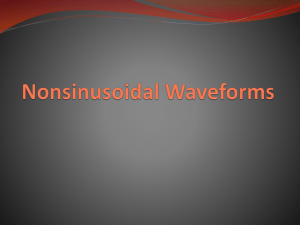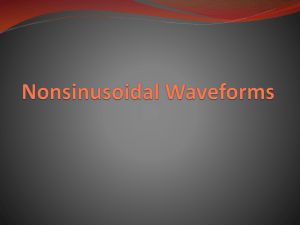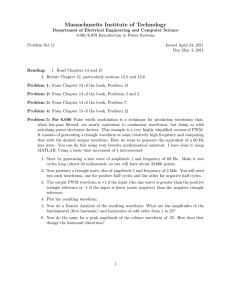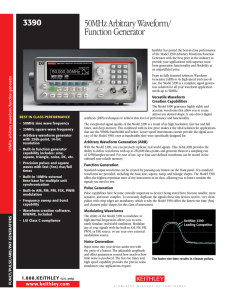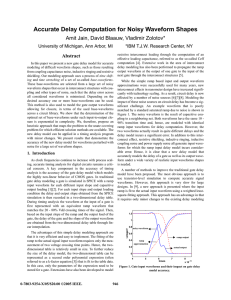Nonsinusoidal Waveforms
advertisement
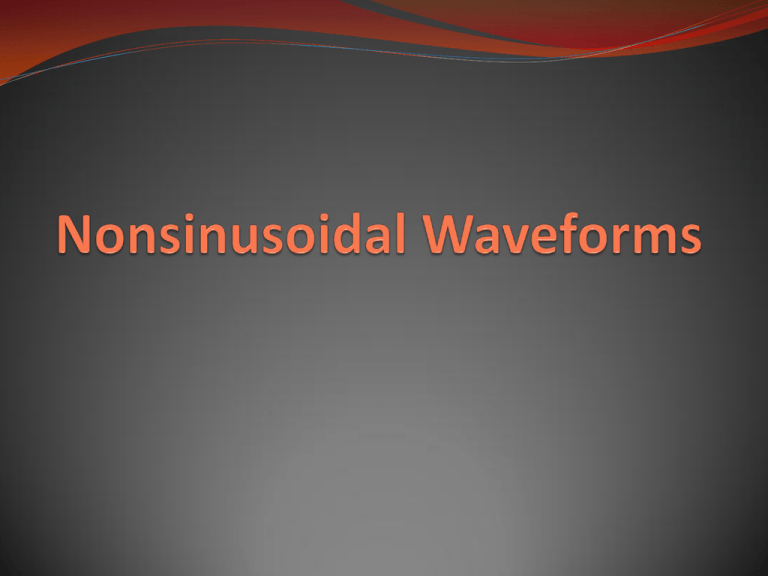
Objective of Lecture Introduce several nonsinusoidal waveforms including Impulse function Step function Ramp function Convolutions Pulse and square waveforms Sawtooth and triangular waveforms Discuss how to obtain a mathematical equation to describe a convoluted waveform. Explain what a composite wavefunction is and define fundamental and harmonic frequencies. Nonsinusoidal Waveforms Not all signals in electrical and computer engineering are sinusoidal. Most digital systems use square waveforms. Although at high switching speeds, these waveforms are starting to look trapezoidal. Most bioelectric signals are nonsinusoidal, many are composite ramp functions. When a switch is opened or closed, the time required for the signals to return to steady state is accompanied by sinusoidal and nonsinusoidal transients. Singularity Functions Are discontinuous or have discontinuous derivatives. Also known as switching functions. They are: Impulse function Unit function Ramp functions Combinations of these functions can be used to describe complex waveforms. Pulse function Square waveform Triangular waveform Sawtooth waveform Unit Step Function 0 t t0 1 t t0 u (t to ) V (t ) Vou(t to ) Unit Impulse Function An impulse function is the derivative of a unit step function. du (t to ) (t to ) dt 0 t to (t to ) t to 0 t to t o (t t 0 )dt (t t0 )dt 1 t o Unit Ramp Function A unit ramp function is the result of the integration of a unit step function. t r (t to ) u (t to )dt (t to )u (t to ) 0 t to r (t to ) t to t to Unit Ramp Function r(t-to) Slope = 1 Pulse Waveform 1 -- Convolution of Two Unit Step Functions 1 -- u (t to ) u (t1 t ) or u (t to )1 u (t t1 ) Square Waveform 3u(t to ) 2u(t t1 ) u(t t2 ) Sawtooth Waveform 1 -- This is a ramp function that is discontinued at time t = t1. To discontinue a ramp function, the function must be multiplied by a second function that doesn’t disturb the ramp when t< t1, but the result of the multiplication is zero for t ≥ t1. Mathematical Formula Sawtooth Waveform is formed by multiplying the Ramp Function times the Unit Step Function 1 r (t to ) u (t1 t ) t1 to Triangular Waveform 4 -- 4 r (t to ) 2r (t t1 ) r (t t2 ) if t1 - to = t2 - t1 t1 to Composite Waveforms Any nonsinusoidal function can be expressed as a sum (or composite) of multiple sinusoidal functions. The sinusoids are related as the frequencies of the sinusoids are integral multiples of some base frequency, known as the fundamental frequency. The higher frequencies are known as harmonics. For even and odd harmonics, the multiplier is an even and odd integer, respectively. The multiplier for 2nd and 3rdharmonics is 2 and 3, respectively. Infinite Square Wave An infinite square wave is a weighted sum of a fundamental sinusoid and its odd harmonics. 1 2n 1t V (t ) sin n 1 2n 1 T 4 T is the period of the square waveform. The fundamental frequency, fo = 1/T. Infinite Square Wave (con’t) Fundamental 2nd harmonic 3rd harmonic n = 20 T = 1 s, fo = 1Hz Summary Several unit functions were described and their mathematical functions were given. The convolution of the unit functions can be used to form more complex functions. Composite waveforms are summations of sinusoidal waves, which is an alternative method to describe complex functions.
